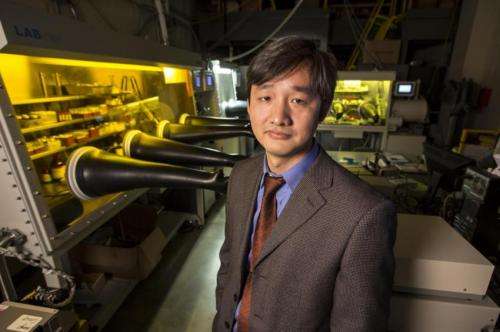UNL researcher wins federal grant for groundbreaking solar energy project

The gap between solar energy's promise and fruition once seemed equal to the distance separating its source from the Earth. That gap has narrowed significantly in recent years and work continues to close it further.
Jinsong Huang, associate professor of mechanical and materials engineering at the University of Nebraska-Lincoln, has earned a four-year, $1.2 million award from the U.S. Department of Energy SunShot Initiative to do his part by improving the efficiency of solar cells. UNL and Iowa State University are providing $144,500 in additional matching funds.
Huang's project will focus on refining solar cells that feature perovskite, which refers to a type of atomic structure and any material that has such structure. Silicon-based cells, the current industry standard, typically convert about 20 percent of captured solar energy into usable electricity. By overlaying silicon cells with a thin film of specially fabricated perovskite, Huang aims to increase that efficiency to at least 30 percent.
"The perovskite structure has been known for more than 100 years, but no one really cared about it for solar cell applications until recently," Huang said. "This material has almost every property a good solar cell needs."
The perovskite readily soaks up sunlight and allows electrons to move freely within it, Huang said, which facilitates the conversion of solar radiation into electricity. The fact that the material is naturally abundant also makes it relatively inexpensive, an important consideration for an industry that continues striving to lower costs, he said.
"We have such abundant solar resources in the United States, but there's still a lot of work to be done to drive down the cost of photovoltaics so that the technology is fully cost-competitive with traditional energy sources," Huang said.
Because the two materials capture different wavelengths of light, pairing silicon with perovskite allows a cell to harvest a broader spectrum of solar energy than either material could alone. Yet Huang said he intends to up the ante even further by making perovskite itself more efficient.
In 2013, Huang introduced techniques that allowed the material to convert a then-record 16 percent of solar energy into electricity. His current project, which includes collaborators from Iowa State, will look to achieve 20 percent efficiency for perovskite solar cells and 30 percent for tandem solar cells.
Huang has developed a new low-temperature fabrication process designed to boost several properties of the perovskite cells. One such property is crystallinity, the extent to which a solid material exhibits a periodic atomic structure.
Though perovskite naturally boasts good crystallinity—which contributes to its solar efficiency—the new process should significantly improve upon its predecessors in this respect, Huang said.
Huang noted that the process should also increase the size of perovskite's grains, which form the foundation of it and other polycrystalline materials. Larger grains result in fewer barriers between them, thereby improving a solar cell's electrical conductivity.
The fabrication process will produce perovskite in the form of a liquid solution, a fact that Huang said should ultimately make it more affordable and accessible.
"You could use the solution like you would ink in a printer or copy machine," Huang said. "Think about how quickly you can print out a newspaper. With this solution, we can hopefully use existing technology to print out solar cells in the future."
Provided by University of Nebraska-Lincoln